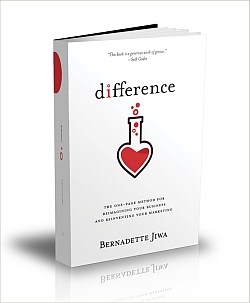How to Reimagine Customer Needs, Reinvent Your Marketing and Make a Difference
Creating stories and experiences that matter to your customers
Consider this practical framework for rethinking how to make a lasting impact on the hearts and minds of your customers by creating stories and experiences that matter to them.
Creating stories and experiences that matter to your customers

By Chuck Frey
Director of Online Training
Content Marketing Institute
By now, you’ve probably heard about the importance of storytelling as a content marketing tactic. But the question remains: how do you actually create stories and experiences that matter to your customers? Bernadette Jiwa, in her new book, Difference: The One-Page Method for Reimagining Your Business and Reinventing Your Marketing, provides a practical framework for rethinking how to make a lasting impact on their hearts and minds.

It’s Time to Get Customer-Centric
Jiwa starts out by making a compelling case for why conventional brand marketing as we know it is broken. Companies today are still so heavily product focused that they fail to imagine creative ways in which they could significantly differentiate their offerings and the customer experience. As a result, marketers waste millions of dollars trying to shove “me-too” products down the throats of their customers, while leaving many of their real, deep needs unmet.
In contrast, Jiwa recommends a more practical, customer-centric approach: Get deep into their heads and discern their needs. Don’t just do focus groups – observe them, ask better questions, and infer needs based on what you see and hear. Then, offer products and services that solve their most pressing problems and stories that bring these solutions to life.
This isn’t a new marketing principle by any means. But Jiwa brings a compelling sense of clarity to this transition and creates a sense of urgency about it. She also showcases companies that are being successful with this approach today. Finally, she provides a framework – the difference map – to help you transform the ways in which you think about your customers and your brand.
The Power of Purpose-Driven Storytelling
The key to differentiating your product or service, Jiwa says, is to craft a story that changes how people feel and gives them something to believe in. The most successful brands today have a larger purpose that informs their storytelling. Examples include Google, TOM’s Shoes and the Dollar Shave Club. In a world where every industry and market has too many brands chasing too few customers, compelling stories are one of the few things that command attention today.
The savviest companies have learned how to ask better questions of their customers and how to observe them – which enables them to infer what their deep needs are. That enables them to develop solutions that closely match with those customers’ worldviews, behaviors, habits and rituals.
“Truly great brands don’t create products and services just to fulfill customer needs. They create for wants, desires, beliefs, behaviors and unexpressed worldviews,” Jiwa explains.
The Difference Model
The Difference Model is a practical framework for discerning the deep-seated needs and emotions of your customers. “(It) flips the product development sequence on its head,” Jiwa says. “Instead of starting with the idea, it begins with an examination of people’s current reality and explores what’s possible in a world where the problems and desires of those people are solved and met.”
The Difference Model is based upon six pillars: principles, purpose, people, personal, perception and product. Jiwa explains what each principle is, its relevance to understanding customer needs and provides examples of each. In addition, she provides a thought-provoking list of questions within each principle that will help you to delve into the unresolved needs of your customers.
All of the information you generate from working your way through Jiwa’s questions is captured in a one-page form, the difference map, which looks similar to the business model canvas and has the same objective – to provide a concise visual summary of your ideas and insights.

To help readers understand how the difference model can be applied to different types of businesses, Jiwa devotes an entire section of the book to displaying and deconstructing the difference maps of many of the companies she mentions in the book. This part is especially instructive, because it transforms the difference model and map from a theoretical construct to a tool that you can use to position your brand to make a difference in the lives of your customers.
What Makes Difference . . . Different
It seems like every business book author today provides some sort of a framework or process. If you faithfully follow it, you’ll be incredibly successful. This has caused many readers, myself included, to become quite jaded when we see these types of structured approaches. But I’m pleased to report that Difference doesn’t fall into this trap. Jiwa provides a wealth of substance here and thought-provoking observations that kept me turning the pages of Difference.
If you’ve spent any time in the worlds of product development or marketing, then you have a very deeply scripted product-centric mindset. It’s going to take some serious mental reprogramming to help you think in terms of everything – your products, services, systems and people – orbiting around your customers and their needs. But Difference is up to the task.
Jiwa provides numerous insights that you can put to use immediately. The one-page format of the difference map makes it easy to think about your own business differently.
Photo source: Flickr user Its All About Rock (:
Need more information?
By Chuck Frey
Director of Online Training
Content Marketing Institute
Part of Z Squared Media LLC
17040 Amber Drive
Cleveland, OH 44111
888-554-2014
contentmarketinginstitute.com

RELATED CONTENT
-
The Not-So-Simple Act of Storytelling
The industries Gardner Business Media reports on grow and evolve constantly. New technologies emerge and change things and become part of the larger story almost constantly. Scott Francis, Editor-In-Chief, Products Finishing discusses the importance of asking questions, listening to the real experts who have devoted their lives to their work, and the role of storytelling in manufacturing.
-
Guide to Generate Leads with Your Content Marketing
With a solid content marketing strategy and these steps in place, your content marketing campaigns will generate leads online like a well-oiled machine.
-
Best Practices in Plants with In-Plant Stories
From the very beginning Gardner has served manufacturing by writing about best practices with most feature articles written by Gardner editors. They write about success stories where companies are using technology to produce better quality parts at lower costs.

